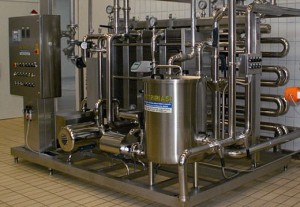The myth of undenatured whey
Undenatured Whey Protein. Really?
To some extent all whey protein is denatured. So let’s start at the beginning, right after the bucket is pulled out from under Bessie.
Raw milk is milk as you’d drink it straight from the tap – raw, with no processing except putting it in a bottle or a glass. You might drink it like this if you live on a farm or own a cow, and although laws vary from state to state, you can’t find raw milk at your local supermarket because it’s illegal to sell to the public. Organic, obviously, isn’t the same as raw.
You can’t buy raw whey protein in the United States, because the FDA requires that commercially sold milk is pasteurized. This is a good thing: disease causing pathogens are destroyed during this process. For the most part, manufacturers will blast the milk for 15 seconds at 72°C. Lower temperatures, as low as 63°C can be used instead, but that requires 1800 seconds (half an hour) of pasturization. The FDA is not flexible on these points, they do not care if you think you have a proprietary method of pasteurizing milk, they’re not interested in how things are done in New Zealand or Australia, they’ll shut you down for not processing dairy products in accordance with U.S. law. This is why people selling “undenatured” whey are still pasteurizing it to the FDA’s satisfaction.
Pasturized milk is where native whey comes from. It’s pasturized and then made directly into whey; not as part of the cheese making process. All other whey, produced during the making of cheese, is pasteurized a second time during that process. Raw milk is not paseturized, Native whey is paseturized once, other whey is pasteurized twice. So that’s raw and native, and how we talk about them on the retail/nutritional market (scientific journals sometimes use the terms interchangeably).
 So what is denaturing? Denaturing (and it’s not a bad word) is any change in the primary, secondary, or tertiary structure of the source material, that takes it away from it’s natural state. Generally denatured proteins function differently than unaltered ones. Notice that word: differently. In some cases, altering these proteins can improve functionality. It’s regularly used in the production of infant formula to make it hypoallergenic. But protein isn’t the only thing in whey; there’s vitamins, minerals, fractions (we’ll get to that in a minute), and a bunch of other stuff. So there’s a lot of things that can be denatured here, and this can be caused by enzymes, temperature, pH alteration…you get the idea. So what exactly gets “denatured” during production?
So what is denaturing? Denaturing (and it’s not a bad word) is any change in the primary, secondary, or tertiary structure of the source material, that takes it away from it’s natural state. Generally denatured proteins function differently than unaltered ones. Notice that word: differently. In some cases, altering these proteins can improve functionality. It’s regularly used in the production of infant formula to make it hypoallergenic. But protein isn’t the only thing in whey; there’s vitamins, minerals, fractions (we’ll get to that in a minute), and a bunch of other stuff. So there’s a lot of things that can be denatured here, and this can be caused by enzymes, temperature, pH alteration…you get the idea. So what exactly gets “denatured” during production?
Whey protein is made up of various fractions, which are (*as you’ve probably guessed) smaller parts of the whole (like in math). Changes in certain fractions are known to occur at 60-62°C, but for the two major ones, Beta-lactalbumin and Alpha-lactalbumin, they begin at 73°C and 66°C, respectively. Some of these (and other) changes can be undone by re-cooling; others can’t. Another way to denature whey is to alter the PH level, which can actually be used to concentrate certain fractions to a higher degree, and improve certain functionality.
Even something as simple as removing the fat from whole milk can alter the proteins. That’s denaturing. Skim milk is denatured. In fact, the mild denaturing that occurs with 2% milk versus whole, actually increases the percentage of whey protein in the final product – so in that case, denaturing milk in this way is good, not bad.
 Generally, the lower temperature-processed whey protein will have higher high levels of glutamylcysteine, which promotes production of the antioxidant glutathione. But low-temperature still means 63°C, a minimum of one degree above the threshold where certain fractions are denatured. The degree of denaturation is commonly established by looking at the proportion of protein concentration soluble at pH 7. But this obviously doesn’t take into account a lot of other changes that the whey could have undergone at the fractional level, or even changes in the vitamin/mineral content, which most of us would consider denaturing. Moreover, glutathione levels are not only increased with native whey protein, but are also increased with regular whey protein isolate – so the idea that a native whey proteins (exclusively) offer this advantage is false. Finally, lower molecular weight whey protein hydrolysate (subject to the most so-called “denaturing”) has been shown to increase glutathione peroxidase (a powerful free-radical scavenger and anti-oxidant) even more than the less-denatured whey protein isolate. So while making make the argument that all whey is denatured, we will also make the argument that denaturing is not necessarily robbing the whey protein of its health benefits (or any other quantifiable property).
Generally, the lower temperature-processed whey protein will have higher high levels of glutamylcysteine, which promotes production of the antioxidant glutathione. But low-temperature still means 63°C, a minimum of one degree above the threshold where certain fractions are denatured. The degree of denaturation is commonly established by looking at the proportion of protein concentration soluble at pH 7. But this obviously doesn’t take into account a lot of other changes that the whey could have undergone at the fractional level, or even changes in the vitamin/mineral content, which most of us would consider denaturing. Moreover, glutathione levels are not only increased with native whey protein, but are also increased with regular whey protein isolate – so the idea that a native whey proteins (exclusively) offer this advantage is false. Finally, lower molecular weight whey protein hydrolysate (subject to the most so-called “denaturing”) has been shown to increase glutathione peroxidase (a powerful free-radical scavenger and anti-oxidant) even more than the less-denatured whey protein isolate. So while making make the argument that all whey is denatured, we will also make the argument that denaturing is not necessarily robbing the whey protein of its health benefits (or any other quantifiable property).
If you get your whey protein from the factory, right after it’s been pasteurized and separated from casein (the other protein in milk), then this is where the story ends. But you probably get your whey protein in a powder form, which means that it’s been concentrated. Oh, and it’s also been made into a powder, and maybe flavored and had other ingredients added.
Ultrafiltration is the most commonly method used to concentrate whey protein, alone or in a combination with microfiltration or nanofiltration. This is exactly what it sounds like, a mechanical filtering process. It’s the most common method because it gives the highest yield of protein versus other methods.
Ultrafiltration uses membranes to hold on to the protein while allowing the lactose and fat to pass through. Standard ultrafiltration allows molecules of only a certain size to pass through. This process, although allowing amino acid ratios to remain constant, increases the relative amount of vitamins/gram and reduces the mineral content, and while it removes bovine serum albumin, it allows many immunostimulatory fractions intact. Take the good with the bad, eh? Microfiltration is ultrafiltration but with a tighter grade of membrane that only allows even smaller molecules to pass through. Both of these processes involve pressure to push the particules through. Obviously different companies have different methods of doing this, some patented, some not, but the broad strokes are similar enough.
That whey protein concentrate you have? This is how it was made…and denatured. In fact, every process on that table above will denature whey to varying extents. And every single process beginning with pasteurization will move whey protein further from the state it is found in nature, hence denaturing it.
Every. Single.One.
Put another way, this means that any whey protein being legally sold in the USA, by definition, has to be denatured. The protein fractions have been changed, the vitamin content has been changed, and the mineral content has been changed.
Let’s review: Pasteurizing milk will denature it, even at the lowest temperature allowed by the FDA, because it will cause changes in certain fractions. Concentrating it will further denature it, as it removes minerals and changes the fraction ratio. There are benefits and drawbacks to this (as there is with anything), and naturally there are also degrees. Not every whey protein powder is denatured to the same extent, but it’s all denatured.
A more highly concentrated (isolated) whey can be made with combination of ion exchange and ultrafiltration. Ion exchange processing means getting the protein away from the other stuff based on their electrical charge. Whey protein is mixed into a solution with positively and negatively charged compounds, and a current is passed through it, and the whey sticks to a collection device (like when you rub a balloon on your shirt and make your hair stick to it – same idea). Ionization alters the proteins found in the whey, meaning...it denatures it.
Still, we have a liquid. At this point, it needs to be dried until it’s a powder (about ~5% moisture). This is typically done by heat evaporation in multistage vacuum evaporators, followed by spray or roll drying, or one pass through a superintense dryer. Relax, this doesn’t “denature” anything. Have we mentioned the condensing process yet? You get the idea…
After this happens, the whey needs to be put in a giant machine where it gets mixed with the flavor package or other ingredients. This is exactly what you think it would be: a giant mixer.
But does this really matter? Probably not. The majority of Whey Protein studies in athletes have been done on this awful, terrible, criminal, denatured whey protein. Those studies almost universally show that whey protein is awesome because it not only enhances performance, but it also helps you build muscle and burn fat, not to mention having a ton of other beneficial properties. So we’re not getting too worked up about any of this. Whey protein is good stuff. Denatured whey protein is non-existent. It’s a marketing gimmick.
Whatever happens before it ends up in your blender or shaker bottle (unless there’s an animal that lactates whey protein concentrate powder), your whey protein is denatured. Whether it’s native whey, whey concentrate, isolate, or hydrolysate, it’s been denatured. If we’re looking at grams of protein and amino acid ratios, then there’s no difference between the whey taken directly from a cow and whey protein powder. If we’re talking vitamins and minerals, and/or specific fractions, then it’s all denatured.




3 Comments. Leave new
So what is your view on the undernatured whey protein in Isagenix which is made from New Zealand cows? Is it a slower digesting protein than regular whey and whey isolates? And how would you say is the quality of this type of protein?
The burden of proof is on anyone claiming that their whey is “undenatured” to prove that it hasn’t been impacted by processing, and to show evidence that it is somehow different than other types of whey that they’re comparing themselves to.
But as a rule, we are not fans of any multi level marketing firms.
Yes, it Isagenix labels say undenatured but it is sold in the U.S and Canada…how so? Is the label misleading. I bought a high grade whey powder that also comes from New Zealand but it is not denatured. It has less sugar than the Isagenix.